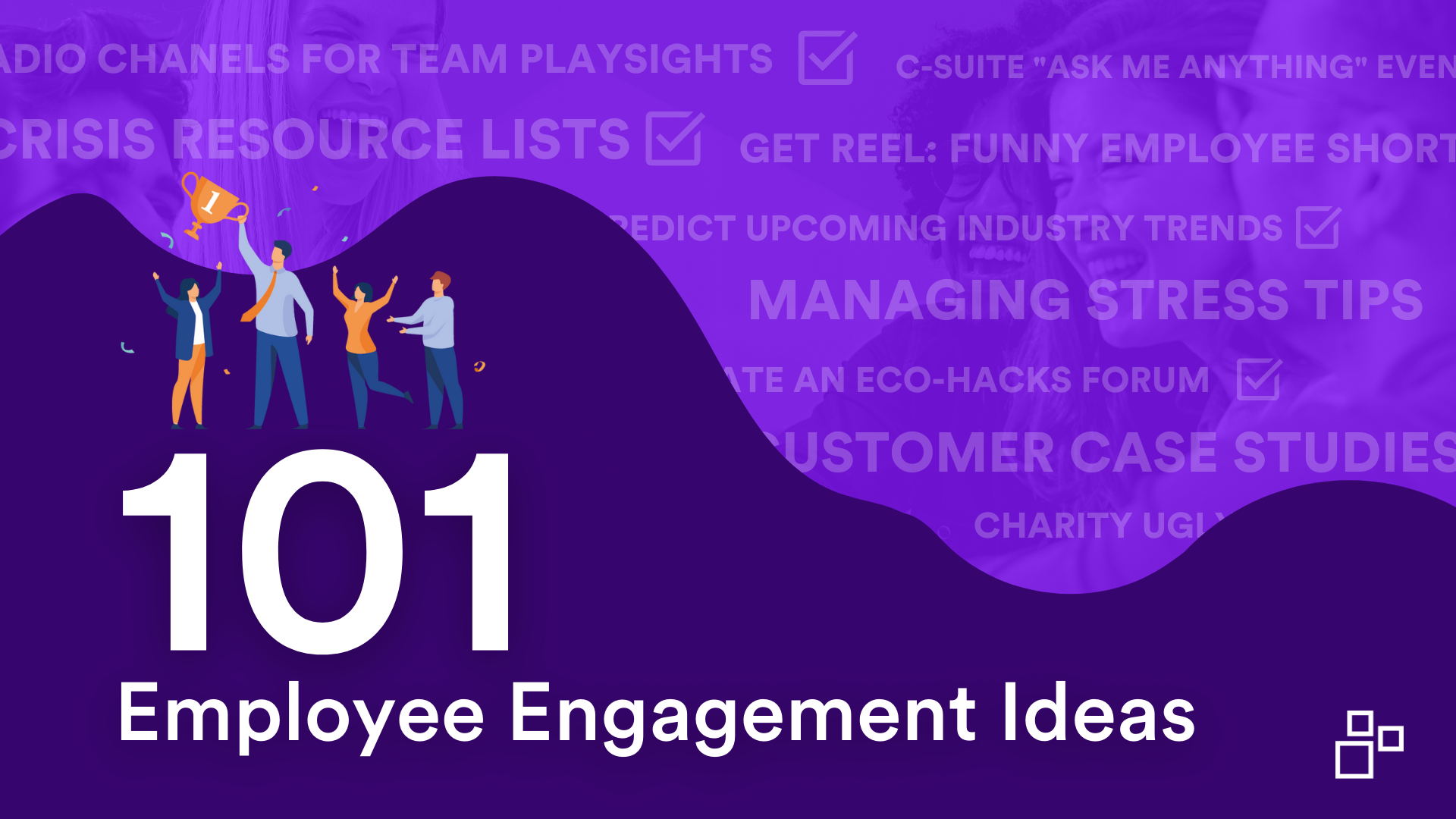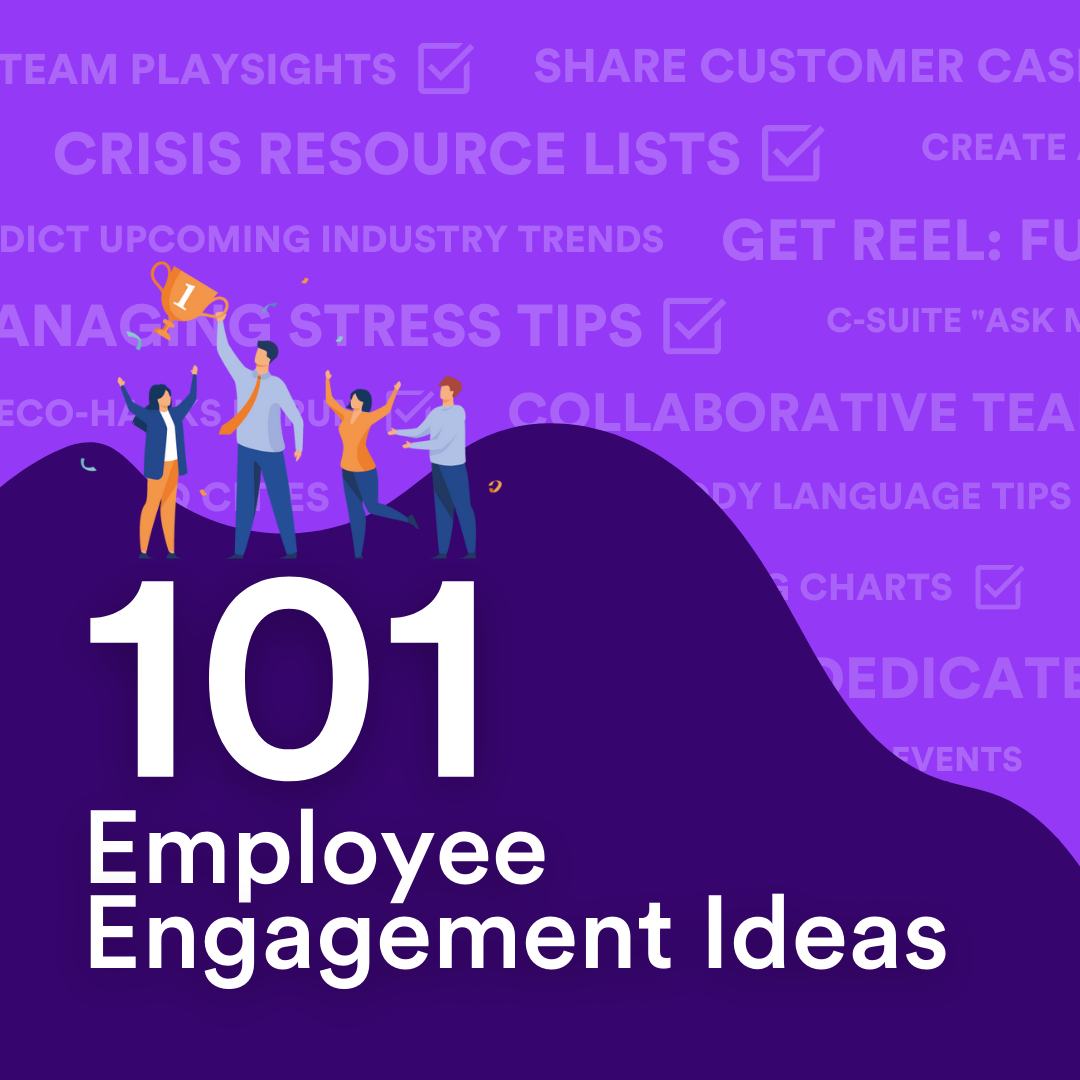If you’re looking for an effective way to improve workplace communication, consider using employee-generated content (EGC) to upgrade your intranet content ideas. Empowering your teammates to create their own engaging content can help foster knowledge sharing and increase how much material your internal communications team can publish.
If employee-generated intranet content sounds like a good but unattainable idea, it may be because in the past you’ve had limited success encouraging employees to publish blogs, update team sites with subject expertise, or contribute to your organization’s social feed.
Like many communicators operating in small teams (or solo), you may have a store of intranet content ideas you hope to deliver, but there are only so many hours in the day. Without EGC, there are rarely enough writers or content creators to make them happen.
One of the biggest obstacles preventing employees from contributing to intranet content ideas is a lack of confidence in writing skills especially. It’s easy to forget when you’re a company’s wordsmith, but not every team member feels the same about writing blog posts or creating scripted videos.
Keep internal comms fresh with 101 Employee Engagement Ideas
Supporting employees to develop their writing skills can help them to flex that muscle more frequently, resulting in additional communication and engagement on your company intranet.
Are EGC and employee communication skills training worthwhile?
To take an analogy from the consumer market, user-generated content (UGC) and influencer marketing have become dominant new paradigms. Research suggests that nearly 80% of consumers say UGC influences purchasing decisions, which makes it over six times more impactful than branded content. Seeing testimony from our friends and family is considered more authentic.
EGC is a variant of user-generated content, and although it generally applies to how employees talk about the company externally (becoming brand advocates), it can also be seen as an internal project. Identifying your influencers and equipping them to create and post their own messages can ensure that intranet content ideas remain fresh and that important team sites, such as departmental pages for HR and Finance, are kept up to date.
The biggest difference from external UGC is that your co-workers are the experts in your product and organization. They know what needs sharing and their input can help everyone else to be more productive and have a clearer view of what is happening throughout the company. Even for professional marketers and communicators though, writing and content creation can be challenging. Research suggests that finding the time and expertise to produce regular, high-quality content marketing is a significant obstacle for some organizations, with 65% of companies admitting to a lack of consistency.
How can I help employees be better communicators?
Keep internal comms fresh with 101 Employee Engagement Ideas
If you want to set subject matter experts up for communications success, the process can be broken up into three main areas:
- Identifying internal influencers
- Offering writing tips and communications strategies
- Supporting with technology
Once you have built more writing confidence in your contributors, you may be able to leverage them more frequently to bring more of your intranet content ideas to fruition.
Identifying internal influencers
Every company has staff members who take a more active and vocal lead in things like Employee Resource Groups and social communities. Those same individuals may also advocate for you on social media, sharing content and job listings. If there’s a good place to begin with identifying intranet contributors, it’s with them.
Locating them may be time-consuming though, so it’s important to have a system that makes identification easier than prolonged social listening.
If your company intranet is equipped with analytics, you will find user profiles of the employees that contribute and interact most with your intranet content ideas. Checking likes, shares, comments, active forum membership, or blogging may be good first indicators if you have time to look, but more advanced intranet software such as Interact will also aggregate data for an ‘Influence Score’. This is a fast way to find people who are actively engaging and sharing with their colleagues.
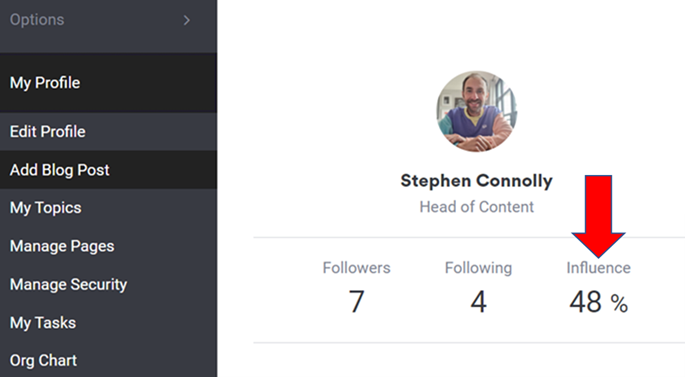
One thing to consider is that many internal communications platforms are permissions-based, so there may be other employees who are less active purely because they require more access. Putting out a call in your comms for new bloggers may also help to drive new EGC contributors.
Offering writing tips and content strategies
Perhaps the biggest hurdle to overcome is supporting people to feel like better writers or content creators. Many organizations already run communications skills training, but few focus on copywriting or content techniques. For this section, we asked company leaders for their tips when creating clear, engaging intranet pages and more.
Keep internal comms fresh with 101 Employee Engagement Ideas
CTO of dofollow.io, Sebastian Schaeffer, suggests content managers should encourage would-be writers to humanize their intranet content ideas.
If you want employees to actually read and engage with your content, you need to make sure it’s interesting. This can be a challenge, especially if you’re covering dry or technical topics. But there are ways to make even the most mundane topics more interesting by adding a human element, using stories, or presenting information in an unexpected way.
Bonnie Whitfield works as the HR Director for Family Destinations Guides. She explains the principles she follows.
Use humor—If you can make people laugh while giving them information that’s relevant to their job, they’ll be more likely to read it and remember it later on down the line.
She adds that technical terms shouldn’t always be discouraged.
If there’s a word or phrase that only applies to your industry or company, don’t worry about using it. Just make sure you explain what it means so everyone understands.
Leszek Dudkiewicz of Passport Photo Online has writerly tips for employees who want to add to your store of company information and culture.
Using words that are familiar to your audience creates a great sense of connection because it evokes the feeling of speaking in the same language. So, to make your internal communication engaging, pay attention to inside jokes and catchphrases.
Leszek adds a note about the importance of grammar too.
Find the grammatical person that fits your message. Every grammatical person and personal pronoun has a different effect. For example, saying “you” to an audience creates distance, which is excellent when you want to establish authority. On the other hand, saying “we” is inclusive and persuasive – it makes people feel they are involved in this message. The art of communication means speaking in the proper grammatical person at the right time.
We have communications experts here at Interact too, of course, so we’ve also assembled some writing tips to remember:
- Be a reader as well as a writer — Becoming a better content creator means consuming more media from different sources. Avidly reading more material means you become alive to differences in tone and style. You may help your employee contributors further by regularly sending them links and news relating to your industry and others. Compile new ideas with Google Alerts and then distribute them via a dedicated Teams/Slack channel or email.
- Don’t be afraid of personality — When it comes to internal content especially, it may be better to let employee contributors use their own voices rather than mandating an external corporate style. Even if they’re writing product pages or updating site content, people will feel more comfortable using words and phrases that come naturally to them.
- Give your page some “eye appeal” — Content creation is more than words on a page. Meaning is important, but considering accessibility and visuality is also key. Simple things like advising on the best font and size to use can make people feel confident that they’re created something engaging for others. More accessible communications and content can also help to support neurodiverse communication in the workplace.
Supporting with technology
Keep internal comms fresh with 101 Employee Engagement Ideas
Internal communications technology has come a long way and your intranet should now be able to support employees to create engaging content too. Each system will differ, but the features below are some of the ways Interact works to increase contributor confidence.
An easy-to-use CMS intranet editor
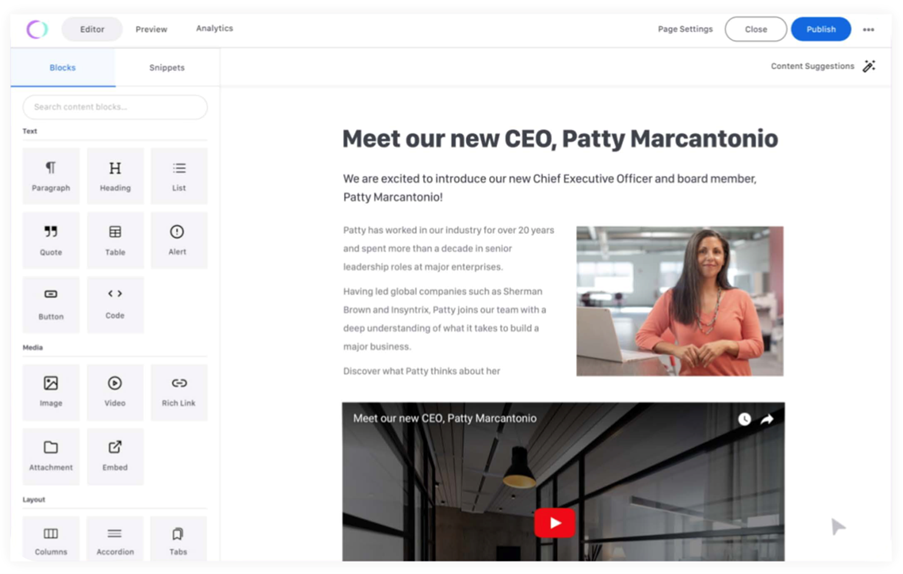
Interact’s content editor features drag and drop controls that make it simple to create key content pages for an organization. Removing any reliance on your creative or intranet governance teams means employees with permissions can assemble engaging intranet pages. Not only does this give subject matter experts control of what they share but ensures that comms managers can devolve control of pages for departments or employee resource groups to other contributors.
Giving users the ability to manipulate headings, tables, quotes, buttons, images, and other media allows them to create professional and digestible content that will keep internal audiences reading. To achieve coherence across your intranet, comms managers can set content templates that all writers can then use to follow.
Inclusivity and sentiment suggestions
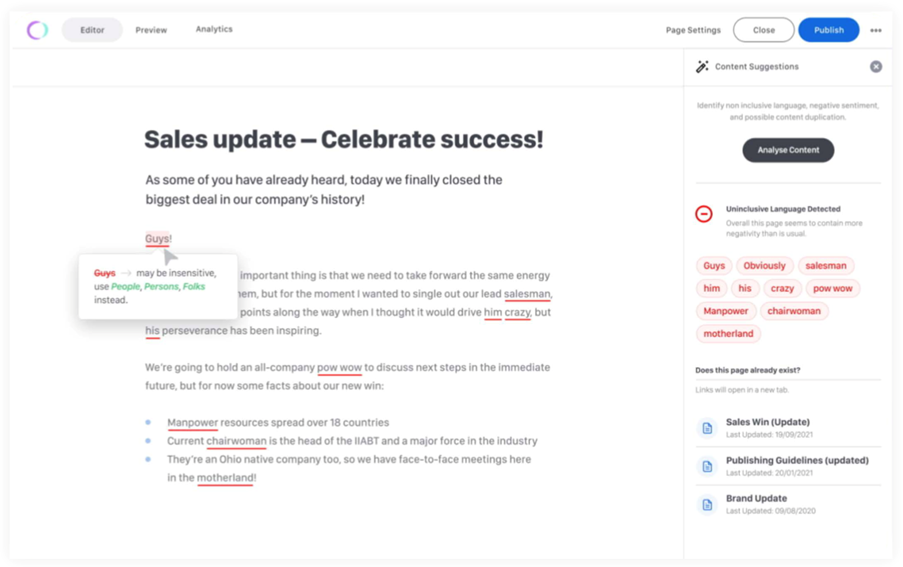
A possible challenge for employees who are less accustomed to writing can be mastering the changing nature of inclusive language. To help them, an AI-based writing tool can automatically detect un-inclusive language or negative sentiment and suggest alternatives.
Mobile blogging
Encouraging people to contribute to your intranet means giving them the ability to do it from anywhere. Now that mobile apps are one of the primary ways users create and consume content, mobile blogging should also be a feature you use to stimulate EGC.
The Interact mobile app enables employees to blog on the go (in addition to commenting, liking, and reading the work of others), so it’s possible for everyone to contribute, even if they don’t spend their days at a desk. Not only does this feature mean individual staff can drive intranet content ideas, but that everyone in your organization can see what is happening on the frontline or in other locations. Creating a sense of community that includes everyone could be key to increasing employee engagement.
Auto summary
Catchy headlines and summaries can help draw people in and increase engagement, but distilling a longer piece into a short paragraph can be difficult. That’s why Interact’s summary tool can automatically capture the important points within a page and summarize its argument for readers.
In addition to making life easier for writers, it can add to the discoverability of intranet content ideas by focusing on the key search terms that users are likely to use when searching.

Some final ideas
The untapped knowledge and passions of a workforce can make a significant difference when it comes to driving the creation of relevant and engaging intranet content ideas. From departmental pages to product updates or personal blogs, everything can help to embed good practices and create better connections between people.
We’ve broken the above ideas into three broad categories, but there is much more that can be done.
- Sharing your content calendar for upcoming topics can stimulate conversations and prompt contributions
- Setting out clear guidelines and acceptable best practices can give much needed advice so that people don’t feel they are creating in a vacuum
- Internal training sessions and skills workshops from Marketing and IC pros can help with communications confidence
- Making leaders more visible through blogs, vlogs, and “written on behalf of” content can generate conversations and engagement
- Creating an online store of brand imagery and logos can even promote external brand advocacy too
We hope that whatever road you take, you can support even more of your co-workers to take up the challenge of sharing their knowledge and expertise with the wider community.
